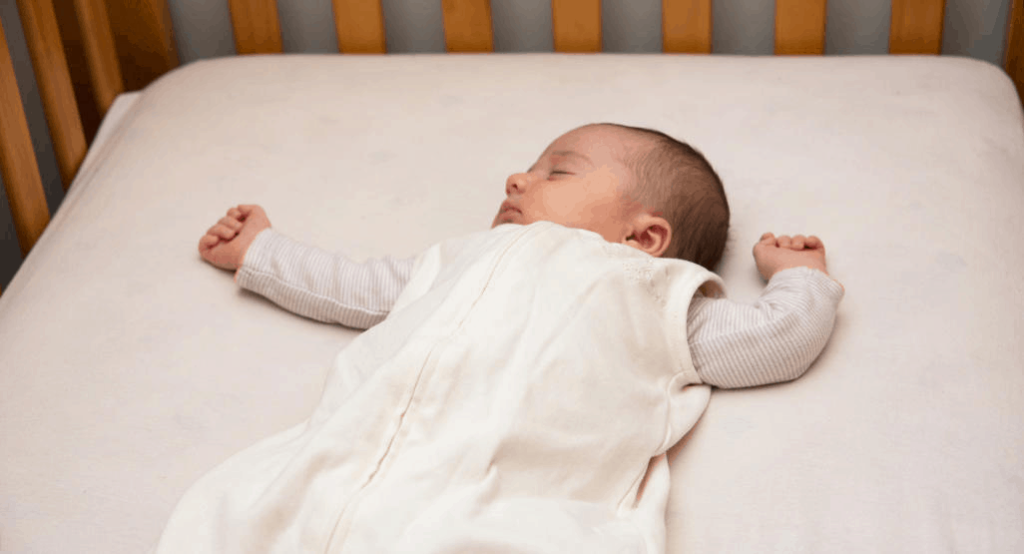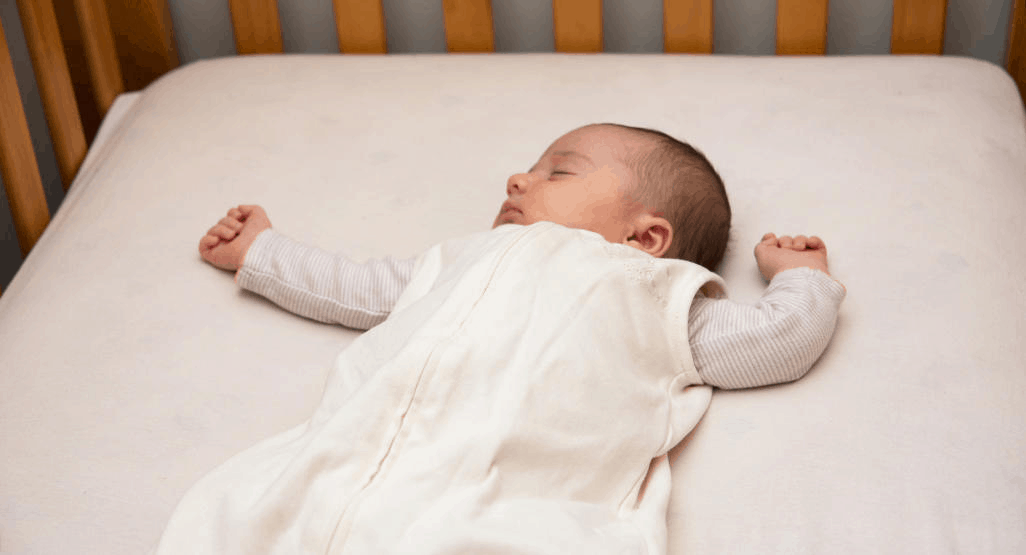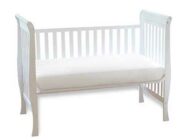Infants spend around 40% of their time sleeping. It’s therefore important to invest in a suitable mattress. Choosing a firm mattress can reduce the risk of Sudden Infant Death Syndrome (SIDS). But how firm does a crib mattress need to be?
A crib mattress needs to be firm enough that it does not conform to the shape of your infant’s head, according to the American Academy of Pediatrics. More specifically, a crib mattress should be between 8 and 10 on the mattress firmness scale. A crib mattress needs to be firm because infants lack motor control in their early stages of development and may sink into a too soft mattress and suffocate.
1 great healthy options we recommend
Related articles:
-
- What mattress fire retardants are there and are there safer options?
- When should you use a cradle bed sleeping wedge to support a baby
- How can you make a cot bed more cozy?
Why Does a Crib Mattress Need to be Firm?
Reasons why a crib mattress needs to be firm include:
- Safety Standards from the CPSC indicate that crib mattresses need to be firm
- There is minor SIDS risk if a mattress is not firm enough
- Firm crib mattresses provide proper Skeletal Support
You may also like to read our article: Do you need a crib mattress?
Safety Standards from the CPSC Indicate that Crib Mattresses Need to be Firm
There are solid safety guidelines that advise parents on the importance of picking a firm crib mattress for their baby. The Consumer Product Safety Commission (CPSC) as well as several professional organizations including experts such as the American Academy of Pediatrics and the National Institute of Child Health and Human Development all recommend that babies be put on a firm mattress. Because newborns and infants can’t roll or move easily on their own, they have difficulties changing positions or shifting their heads. If your crib mattress is too soft, it will conform to the shape of your baby’s head, which can be uncomfortable and dangerous. This is where having a firm mattress matters. In addition to reducing the risk of SIDS, having a firm crib mattress provides resistance necessary to support proper skeletal and muscle development. This is especially the case when your baby becomes active in the crib, starts turning, and eventually stands up.
There is Minor SIDS Risk if a Crib Mattress is Not Firm Enough
A soft mattress increases the risk of Sudden Infant Death Syndrome. As mentioned above, babies lack mobility in their first two to three months of age and since soft mattresses can conform to the shape of your baby’s head or face, they can lead to smothering and death if you baby rolls over onto their stomach. Additionally, a soft mattress may create gaps between its edge and the crib’s edge, making it possible for your baby to get stuck in these gaps. Firm mattresses provide resistance to indentations and don’t create gaps, which ensure protection and minimize the risk of SIDS.
Firm Crib Mattresses Provide Proper Skeletal Support
Babies’ skeletons are very different from adults’ skeletons. Babies are born with around 300 soft and fragile bones, whereas adults have 206 bones. Therefore, babies require more support than adults do. As babies develop and grow, some of their bones fuse together, which decreases the actual number of bones. So when it comes to crib mattresses, bear in mind that babies’ spines need more support than what adults need. What feels comfortable for you is probably too soft for your baby. Therefore, a firm mattress is key for better support and safety.
What crib mattress size should you choose? View our guide.
 Firm mattresses reduce the risk of SIDS and support proper skeletal development. Image from Babycenter.
Firm mattresses reduce the risk of SIDS and support proper skeletal development. Image from Babycenter.How to Test The Firmness of a Crib Mattress, Method 1
We will provide you with two methods to testing how firm a crib mattress needs to be. Follow these steps for the first method:
- Find a crib mattress with a flat and firm surface
- Exert pressure into the middle and sides of the mattress
- Check the recall list
- Test the mattress inside the crib
Step 1: Find a crib mattress with a flat and firm surface
Observe the physical condition of the mattress. Make sure that there are no peaks and valleys or any lumps.
Step 2: Exert pressure into the middle and sides of the mattress
Press your hand onto the center and the sides of the mattress. If the mattress is firm, it does not conform to the shape of your hand and quickly snaps back into place.
Step 3: Check the recall list
Before placing the mattress into the crib and using it, double check if the manufacturer has recalled the mattress because of some defect or safety concern.
Step 4: Test the mattress inside the crib
Set the mattress inside the crib then apply pressure on its edges. If the mattress is firm, the edges will be too strong to be pushed inwards. Therefore, the mattress won’t create gaps.
Related articles:
- How do you store a crib mattress and make sure it stays firm?
How to Test The Firmness of a Crib Mattress, Method 2
You may also want to assess the firmness of your mattress by using household supplies. So gather a ruler, a marker, 12 CDs, kitchen cling wrap, and two 1-litre cartons of milk squared bottoms. Now follow these steps:
- Wrap the CDs in kitchen cling wrap
- Measure and mark one of the milk cartons
- Arrange the cartons on top of the CDs
- Observe the overhanging portion of the carton
Step 1: Wrap the pile of CDs
Stack 12 CDs and Wrap them tightly in kitchen cling wrap to ensure they stay in a pile and in good condition. Then place the wrapped CDs in the middle of the mattress (which is generally the softest part). Refer to image (a) below.
Step 2: Mark one of the milk cartons
Take one milk carton and measure 40 mm from the bottom edge of the milk carton using your ruler. Then take your marker and draw a line parallel to the bottom of the carton. Refer to image (b) below.
Step 3: Arrange the cartons on top of the CDs
Place the milk carton horizontally on top of the wrapped CDs. The drawn ring should be lined up with the edge of the topmost CD. Refer to image C below. Then place the other carton horizontally on top of the first one however you need to in order to maintain balance.
Step 4: Observe the overhanging portion of the carton
Observe the portion below the drawn line. If the portion touches the mattress, then the mattress is too soft and not safe for your baby. However, if the portion remains upright and doesn’t come into contact with the mattress, then you can be reassured that your mattress is firm and safe. Refer to image (d) below.
When Can Your Baby Sleep on a Soft Mattress
It is recommended to use a firm crib mattress for your newborn. However, there are soft mattresses that meet safety standards and can be used right after birth. Softer mattresses such as Newton baby are currently manufactured with new technologies, which make them safe and breathable. There are also convertible mattresses with dual firmness that you can flip anytime like this Milliard Crib Mattress: One side is firm for babies, while the other side is softer for toddlers.
Switching from a firm mattress to a softer one is associated with age, life situation, and preferences. Parents usually wait for the baby to become too big or too active to sleep on his crib to transfer him to a new bed with probably a new and softer mattress.
A baby can sleep on a soft mattress when he/she is:
- older than 12 months and has better motor control
- can roll over, crawl, and able to climb out of the crib
- has the dexterity to reposition when sinking into the mattress
- ready to transition to a toddler sized bed
- able to sleep on their side
- suffering from spine or back problems due to birth defects
How to choose a firm mattress for a crib
The firmness of the mattress is associated with its material and composition. Foam and innerspring mattresses are two common types of crib mattresses that offer ideal support for babies and toddlers. A useful rule of thumb that tells you a mattress is firm is as follows: When the baby is laid on the firm mattress, his weight is evenly distributed. So the surface of the mattress stays flat and even with little to no sinking and it hardly conforms to the shape of the baby’s body and head. Here are three of the best crib mattresses (in the table below), which you can find on Amazon:
| Product and link | Price |
| Dream On Me Spring Crib | $52.70 |
| Graco Premium Foam Crib | $69.00 |
| Colgate Eco Classica III | $204.99 |


